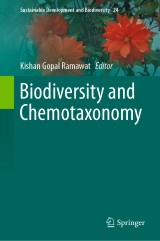Details

Biodiversity and Chemotaxonomy
Sustainable Development and Biodiversity, Band 24
|
CHF 177.00 |
|
| Verlag: | Springer |
| Format: | |
| Veröffentl.: | 10.11.2019 |
| ISBN/EAN: | 9783030307462 |
| Sprache: | englisch |
Dieses eBook enthält ein Wasserzeichen.
Beschreibungen
<p>Plant classifications are based on morphological characters and it is difficult, particularly in small plants and grasses, to identify these below generic level on the basis of these characters using a dissecting microscope. Plant species have intra- and inter-specific variation in secondary metabolites which can be utilized as marker compounds for identification and classification of plants. Secondary metabolites are produced as a result of primary metabolism and the production of these compounds not only involves several genes but also it is an energy dependent process. Hence these products cannot be considered as insignificant for the plant and the environment. Modern tools of molecular biology and secondary metabolites present in them can definitively decide about classification of plants. Absence of correct identification of plant is associated to many problems of resource utilization. Due to wide availability of these tools, interest has revived in systematics and correct classification of plants based on these parameters for their sustainable utilization and resource management.</p>
<p>The purpose of this book is to assess the potential of phytochemical and molecular tools in the systematic and classification of plants. The topics covered include species concept, barcoding and phylogenetic analysis, chemotaxonomy use of polyketides, carotenes, cuticular wax, volatile oils, biodiversity of corals, metazoans, <i>Ruta</i> and <i>Echinocereus.</i><br></p>
<p>It provides comprehensive and broad subject-based reviews, useful for students, teachers, researchers, and all others interested in the field. The field has been kept wide and general to accommodate the wide-ranging topics. This book will be useful to agriculturists, chemists, botanists, industrialists, and those involved in planning of crop plants.<br></p>
<p>The purpose of this book is to assess the potential of phytochemical and molecular tools in the systematic and classification of plants. The topics covered include species concept, barcoding and phylogenetic analysis, chemotaxonomy use of polyketides, carotenes, cuticular wax, volatile oils, biodiversity of corals, metazoans, <i>Ruta</i> and <i>Echinocereus.</i><br></p>
<p>It provides comprehensive and broad subject-based reviews, useful for students, teachers, researchers, and all others interested in the field. The field has been kept wide and general to accommodate the wide-ranging topics. This book will be useful to agriculturists, chemists, botanists, industrialists, and those involved in planning of crop plants.<br></p>
1. Introduction.- Part I: Biodiversity.- 2. Generation of Data on Reproductive Ecology is Important for Effective Conservation of Our Plant Diversity.- 3. Molecular Approaches to Explore Coastal Benthic Metazoan Diversity - Success and Constraints.- 4. Soft Corals Biodiversity in the Egyptian Red Sea.- 5. Assessment of Grasslands in Indian Desert - a Holistic Approach.- Part II: Chemotaxonomic Markers.- 6. Chemotaxonomy Significance of Alkaloids in Plants.- 7. Iridoids as Chemotaxonomic Marker.- 8. Chemosystematic Significance of Flavonoids.- 9. Isoquinoline Alkaloids as Chemotaxonomic Markers.- 10. Saponin Diversity in Plants.- 11. Chemotaxonomy and Chemodiversity of Fungal Polyketides.- 12. Chemotaxonomic Profiling for High-Value Caretonoids in Microalgae.- 13. Fungi.- Part III: Diversity and Phylogeny.- 14. Plant Barcoding and Phylogenetic Analysis: Advances, Challenges and Future Trends.- 15. Molecular Techniques to Assess Plant Diversity.- 16. Diversity of the Genus <i>Ocimum</i>.- 17. Phylogeny in Echinocereus (Cactaceae): Taxonomic Implications.- 18. Genetic Variation in <i>Brassica</i> and Allied Genera.- Part IV: Case Studies in Chemotaxonomy.- 19. Chemotaxonomic Survey on the Genus Sedum L. (Crassulaceae) Based on Distribution and Variability of the Epicuticular Wax Constituents.- 20. Chemotaxonomic Study of Volatile Oils from Rhizomes of Zingiber species (Zingigeraceae).- 21. Chemical Variability in Essential Oils from Ruta Species and its Taxonomic and Ecological Significance.- 22. Conclusions.
Plant classifications are based on morphological characters and it is difficult, particularly in small plants and grasses, to identify these below generic level on the basis of these characters using a dissecting microscope. Plant species have intra- and inter-specific variation in secondary metabolites which can be utilized as marker compounds for identification and classification of plants. Secondary metabolites are produced as a result of primary metabolism and the production of these compounds not only involves several genes but also it is an energy dependent process. Hence these products cannot be considered as insignificant for the plant and the environment. Modern tools of molecular biology and secondary metabolites present in them can definitively decide about classification of plants. Absence of correct identification of plant is associated to many problems of resource utilization. Due to wide availability of these tools, interest has revived in systematics and correct classification of plants based on these parameters for their sustainable utilization and resource management.<p>The purpose of this book is to assess the potential of phytochemical and molecular tools in the systematic and classification of plants. The topics covered include species concept, barcoding and phylogenetic analysis, chemotaxonomy use of polyketides, carotenes, cuticular wax, volatile oils, biodiversity of corals, metazoans, <i>Ruta</i> and <i>Echinocereus.</i><br></p><p>It provides comprehensive and broad subject-based reviews, useful for students, teachers, researchers, and all others interested in the field. The field has been kept wide and general to accommodate the wide-ranging topics. This book will be useful to agriculturists, chemists, botanists, industrialists, and those involved in planning of crop plants.</p>
At present no recent book on the subject Combines biodiversity and chemotaxonomy Helpful in sustainable resource identification and utilization Covers lower plants to angiosperms
Diese Produkte könnten Sie auch interessieren:

The Vicuña

von: Iain Gordon, Jane C. Wheeler, Hugo Yacobaccio, Jerry Laker, Marcelo Cassini, Mariela Borgnia, Yanina Arzamendia, Verónica Benítez, Bibiana Vilá, Cristian Bonacic, Jessica Gimpel, Pete Goddard, Desmond McNeill, Gabriela Lichtenstein, Renaudeau d' Arc Nadine, Kristi Anne Stølen, Javier García Gomez, Ana Wawrzyk

CHF 118.00

Saving Biological Diversity

von: Robert A. Askins, Glenn D. Dreyer, Gerald R. Visgilio, Diana M. Whitelaw

CHF 118.00

Martens and Fishers (Martes) in Human-Altered Environments

von: Daniel J. Harrison, Angela K. Fuller, Gilbert Proulx

CHF 177.00













